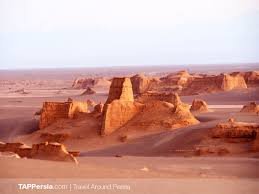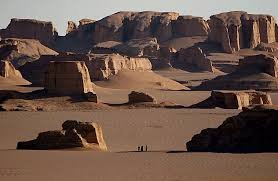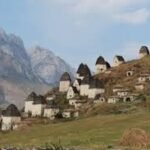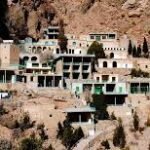In the stark expanse of southeastern Iran lies Dasht-e Lut, a 51,800 square kilometer desert so extreme it holds the title of Earth’s hottest recorded land surface temperature – a blistering 80.8°C (177.4°F) measured by NASA satellites in 2005. This UNESCO World Heritage Site presents a surreal panorama of geological wonders that appear more Martian than terrestrial, with towering sand castles, razor-edged yardangs, and vast dune fields that sing in the wind. The Lut Desert’s combination of extreme heat, mysterious formations, and complete absence of visible life creates an environment so hostile that even Bedouin nomads avoid it, referring to the area as “the place where nothing lives.” Yet within this apparent wasteland lies extraordinary beauty and scientific mysteries that continue to puzzle geologists and climate researchers.
Dasht-e Lut The Furnace of the World: Record-Breaking Heat
Dasht-e Lut’s heat extremes result from a perfect storm of geographical factors. The desert sits in a low-elevation basin (about 200m above sea level) surrounded by mountains that trap hot air, while its dark volcanic gravel absorbs 90% of incoming solar radiation. Summer temperatures regularly exceed 50°C (122°F) in the shade, with surface temperatures hot enough to fry eggs on the rocks. NASA’s MODIS satellite recorded the 80.8°C reading in the Gandom Beryan (“Toasted Wheat”) area, where local legend claims a load of wheat left by a caravan was baked black in place. The air is so dry that sweat evaporates instantly, offering no cooling effect, while windstorms can raise sand temperatures to 100°C (212°F) – near the boiling point of water. Remarkably, nighttime temperatures can plummet to near freezing, creating daily temperature swings of 70°C (126°F) that shatter rocks through thermal expansion.
Kaluts: The City of Ghostly Towers of Dasht-e Lut
The desert’s most iconic feature is the Kaluts – a 145km long field of yardangs (wind-eroded ridges) resembling a ruined metropolis. These parallel crests, some reaching 155m tall, were carved over millennia by the “Lut Wind,” a constant northwesterly that blows at hurricane speeds (up to 120km/h) for 120 days each summer. The Kaluts’ corridors form perfect straight lines with mathematical precision, their fluted walls displaying rainbow-colored strata of sedimentary rock. At sunset, the formations cast elongated shadows that create an optical illusion of infinite depth, while moonlight transforms them into a surreal silver labyrinth. Local legends speak of djinn inhabiting the Kaluts, and nomadic tribes report hearing whispers and footsteps in their winding passages. Scientists have discovered the ridges emit infrasound frequencies below human hearing range, potentially explaining these eerie auditory phenomena.
The Singing Sands and Moving Dunes of Dasht-e Lut
In the eastern Lut, massive sand dunes rise up to 300m – among Earth’s tallest – with slopes so steep they approach the angle of repose. These dunes “sing” with a low-frequency hum when winds dislodge grains of particular sizes and shapes, creating vibrations that resonate across the desert. The phenomenon occurs most frequently at dawn, when temperature changes create ideal conditions, and can be heard up to 10km away. Even more remarkably, satellite imagery shows the dunes migrate up to 30m annually, their movements revealing previously buried geological layers. In 2016, researchers discovered the dunes contain microscopic magnetite particles that align with Earth’s magnetic field, potentially explaining their unusual north-south orientation. The area also contains rare “star dunes” with three or more arms radiating from central peaks – formations so complex they’ve only been found in three other deserts worldwide.
Gandom Beryan: The Mysterious Black Desert
The northern Lut features Gandom Beryan (“Toasted Wheat”), a 480km² plateau covered in dark volcanic pebbles that absorb nearly all sunlight. This is where NASA recorded its extreme temperatures, with the black stones becoming too hot to touch within minutes of sunrise. The area contains mysterious polygonal cracks resembling giant turtle shells – patterns typically seen in Arctic permafrost, not scorching deserts. Geologists believe these formed when the region was wetter during the Pleistocene, preserved by the ultra-dry climate. More puzzling are the “desert tears” – perfectly spherical basalt balls up to 30cm in diameter scattered across the plateau. Some show concentric layering like enormous stone onions, while others appear hollow with crystalline interiors. Local mythology claims these are the petrified tears of a heartbroken giant, but scientists suspect they formed through a rare combination of volcanic activity and mineral accretion.

The Impossible River and Disappearing Lakes
Contrary to its reputation as a waterless hellscape, the Lut hides surprising hydrological secrets. Satellite radar has revealed fossilized river channels beneath the sands, including one ancient watercourse that once flowed year-round despite the desert’s evaporation rates. Even more astonishing are the temporary lakes that form after rare rainfalls in the Nehbandan fault zone. These ephemeral bodies of water appear overnight, sometimes reaching 15m depth, only to vanish completely within days through a combination of rapid evaporation and drainage into subterranean cavities. In 2018, a research team documented microbial life flourishing in these short-lived lakes – organisms that enter suspended animation when waters disappear and revive years later when rains return. The most mysterious water feature is the “Blind Spring,” a periodic geyser that erupts boiling water (measured at 63°C) without any visible volcanic activity to explain its heat source.
Archaeological Mysteries of the Lut’s Lost Civilizations
Though uninhabited today, the Lut’s margins contain ruins suggesting ancient cultures braved its extremes. The most puzzling is Shahr-e Gholghola (“City of Screams”), a 5,000-year-old settlement with sophisticated qanat irrigation systems that somehow drew water from the desert. Pottery fragments found here depict creatures resembling modern descriptions of desert “sandworms.” Nearby lies the Chehel Dokhtar caravanserai, a 12th-century waystation where archaeologists discovered skeletons in poses suggesting sudden, violent death – possibly from a freak hyperthermal event. The desert also contains hundreds of unexplained “desert kites” – stone structures forming giant arrows pointing to water sources, some dating back 7,000 years. Recent LiDAR surveys have revealed an extensive network of buried roads connecting these sites, suggesting the Lut was far more traversable in antiquity than today.
Extremophiles and the Limits of Life
While visibly lifeless, the Lut harbors microorganisms that redefine life’s possible conditions. Scientists have identified:
- Cyanobacteria living inside translucent quartz rocks
- Archaea thriving in 70°C brine pools
- Lichens that absorb moisture directly from the air
Most remarkable are the “zombie microbes” found in 2019 – organisms that remain metabolically active at 84°C, the hottest known limit for terrestrial life. Researchers believe Lut’s extremophiles may hold clues to life’s origins on Earth and its potential on exoplanets. The desert’s UV radiation levels (among Earth’s highest) have even led NASA to test Mars rover components here. In 2021, a joint European-Iranian team discovered bacteria producing novel antibiotics effective against drug-resistant pathogens – a potential medical breakthrough from one of Earth’s most inhospitable places.
Dasht-e Lut Visiting the Unvisitable: Extreme Desert Tourism
Despite its dangers, the Lut attracts adventurous travelers between October-April when temperatures are merely hot rather than lethal. Expeditions require special permits and local guides who know how to navigate the featureless terrain. Visitors describe surreal experiences:
- Walking the Kaluts at dawn when shadows create optical illusions of floating
- Watching “sandfalls” where cascading grains mimic water
- Camping under stars so bright they cast shadows
The most daring hike to the “Lut’s Navel” – a volcanic crater with multicolored mineral deposits – while others seek out the mysterious “Desert Eye,” a perfect circular depression of unknown origin. All must contend with the desert’s hazards: sudden sandstorms that erase trails, 15°C temperature swings in minutes, and the psychological toll of endless, lifeless vistas.
Dasht-e Lut stands as a monument to Earth’s extremes – a place where the planet’s raw geological forces are laid bare without the softening veil of vegetation or human presence. Its landscapes challenge our perceptions of what environments can exist on our world, while its hidden biological treasures suggest life’s incredible adaptability. As climate change makes more regions Lut-like, this Iranian desert serves as both warning and wonder – a furnace that burns away preconceptions to reveal nature’s astonishing resilience and mystery. Whether viewed as a hellscape or natural masterpiece, the Lut demands respect as one of Earth’s last truly untamed places.
Go to main page


